Lunar sights Before the Pink Paschal Mini Moon Covers Spica, Uranus Sinks Out of Sight, and Venus Gleams in Morning!

This terrific image of the large craters Copernicus and Eratosthenes (on its right) was produced by Jerry Lodriguss on July 11, 2011 using a Celestron C11 telescope. Note the blanket of ejected material around Copernicus, its terraced interior rim, and central peaks. Jerry’s work can be enjoyed at his website www.astropix.com
Hello, Moon-gazers!
Here are your Astronomy Skylights for the week of April 6th, 2025 by Chris Vaughan. Feel free to pass this along to your friends and send me your comments, questions, and suggested topics. You can also follow me on FaceBook, Instagram, Threads, and Bluesky as astrogeoguy! Unless otherwise noted, all times are expressed in Eastern Time. To subscribe to these emails please click this MailChimp link.
If you’d like me to bring my Digital Starlab portable inflatable planetarium to your school or other daytime or evening event in Simcoe, Grey, and Bruce Counties, or deliver a virtual session anywhere, contact me through AstroGeo.ca, and we’ll tour the Universe, or the Earth’s interior, together! My book with John A. Read entitled 110 Things to See With a Telescope is a guide to viewing the deep sky objects in the Messier List – for both beginners and seasoned astronomers. DM me to order a signed copy!
Since the bright moon will absolutely dominate the evening sky this week while it waxes to Saturday’s Full Pink Paschal Mini moon, I offer some sights on it to see and some background on how astronomy controls Easter and Passover. Meanwhile, the planet Uranus will depart the evening sky, leaving only Jupiter and Mars – for now, and Venus will gleam above three other planets in the east before sunrise. Read on for your Skylights!
Viewing the Moon
Springtime is an excellent time to view the moon. I carried out three lunar observing programs offered by the Royal Astronomical Society of Canada (RASC) during the springtime. Details about the two shorter ones are here. Spring weather is lovely and the bugs are still sleeping. Moreover, the moon is high enough in the evening sky that atmospheric turbulence is reduced, producing crisp, clear views of it under magnification. Since the moon’s orbit is nearly perpendicular to the western horizon after sunset in spring, the very young crescent moons that occur just after the sun sets sit higher in the sky and linger longer after sunset than at the other times of the year.
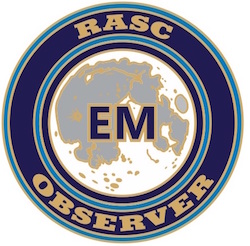
The RASC lists of the most interesting features on the moon are freely available to anyone, whether or not you decide to pursue their programs formally. If you decide to look at the smaller details on the moon that unaided eyes and binoculars can’t resolve, you’ll find that steady air, a sturdy telescope mount, and lots of magnification are essential. (The telescope eyepieces with the smaller numbers on them magnify things the most. You might even need to use that funny Barlow Lens that your telescope came with. Barlow Lenses normally magnify too much and narrow your field of view so much that you can’t keep targets in the eyepiece. They’re often of poor quality, too, so I usually advise against using them.)
You don’t need a large telescope to explore the moon’s secrets. Select a model based on good quality optics, mount sturdiness, and convenience. If it’s too big or tricky to set up, you won’t be bothered to use it. While refractor telescopes (the type with a glass lens across the opening of the telescope tube) usually work well out of the box, reflector telescopes (with the large mirror inside at the bottom) often need to be collimated to perform at their best.
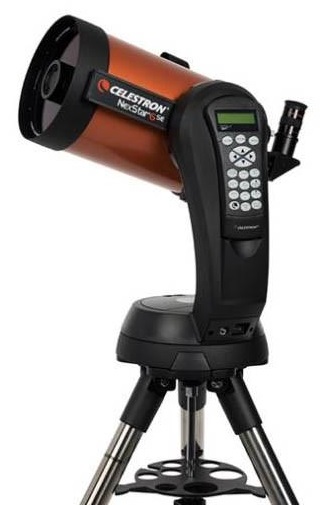
Collimation involves adjusting the mounting screws to align the mirrors precisely. If the mirrors are slightly out of alignment, your views will never quite be crisp. You can do your own collimating, but I’d advise finding an astronomer to help you the first time. Compound telescopes with both mirrors and lenses benefit from collimation, too. Schmidt-Cassegrain telescopes (SCT, for short) and Maksutov telescopes are stubbier than the other types because they have a glass “window” across the front which is actually a thin lens, a large mirror at the bottom of the tube, and a smaller, hidden mirror mounted behind the front glass. They need collimating, too.
Last week, I highlighted some sights to see as the moon waxed from new to first quarter on Friday. This week, the moon will wax to full on Saturday. Everyone on Earth sees the same moon phase once it rises in their time zone. At any given time, about half of the world is seeing the moon simultaneously – though it may be just rising or just setting for some. Let’s continue with the moon-doings for this week. Our evening stargazing and spring galaxy-hunting will be impaired by bright moonlight until our natural night-light departs.
For the next two weeks, more than half of the bright, sun-facing hemisphere of the moon’s globe will be rotated onto the moon’s Earth-facing hemisphere, giving us gibbous moon phases and loads of moonlight. The terrain alongside the pole-to-pole terminator line will be bathed by nearly horizontal rays of sunlight and casting long, inky-black shadows to the west of even the smallest humps and bumps. The lunar terrain looks spectacular under these conditions whether you are just looking up with your eyes, using any size of binoculars, or viewing the moon through a telescope. Unfortunately, as we approach the full moon phase, most of the moon’s surface is receiving sunlight from on high, reducing the amount of shadows cast and flattening its appearance. While full moons are spectacular to the eye, they are rather blah under magnification.
Let’s look at what the moon will get up to this week.
Tonight (Sunday) the 70%-illuminated moon will rise after lunch and cross the daytime sky. You can safely view the moon in daytime with binoculars and telescopes as long as you take special care not to aim them anywhere near the sun. I usually keep the lens caps on until I am pointed at the moon, and then remove them. Parental supervision is essential for daytime telescope usage. To increase the contrast on a daylit moon, wear polarized sunglasses (or cinema 3D glasses) while you are looking into the telescope, and then rotate your face until the sky darkens. Some folks own polarized filters that screw onto the telescope lens. Just loosen and rotate the filtered lens until the sky darkens.
When the sky darkens on Sunday night the bright moon will shine just to the left (or celestial east) of the faint stars of Cancer (the Crab). Mars and the two bright stars of Gemini (the Twins) will form a line off to the moon’s right and the bright, sickle-shaped stars of Leo (the Lion) will sparkle on the moon’s left. The upper portion of the moon will be dominated by the spectacular, mountain-rimmed Mare Imbrium “the Sea of Rains”, though still half in shadow. Watch for the dark smooth oval of the crater Plato along the northern rim of dark Mare Imbrium and the smaller crater Eratosthenes along the south. The rest of the region along the terminator will be littered with craters of the bright, lunar highlands. My favorite crater Clavius, with its curved set of craters that diminish in diameter within, will hug the terminator near the moon’s bottom.
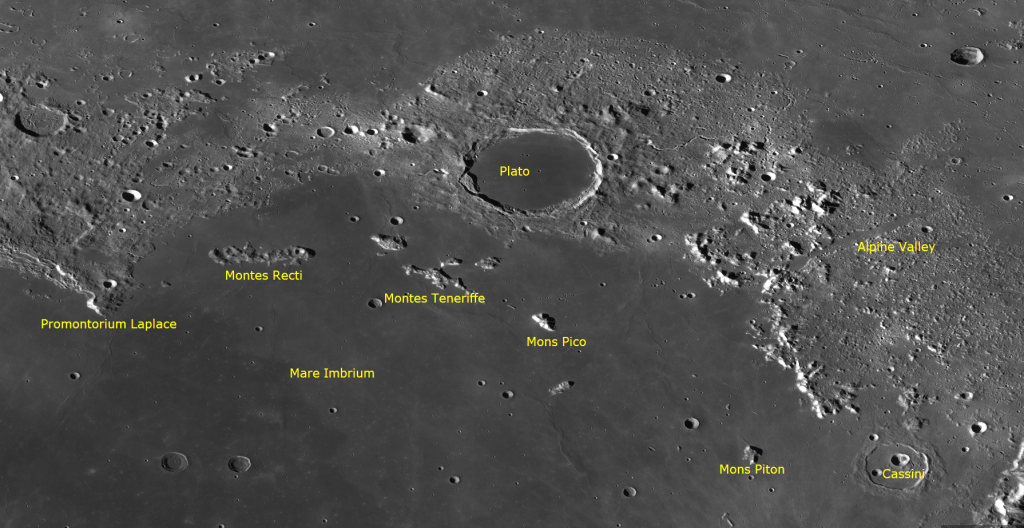
From Monday to Wednesday the steadily brightening, waxing gibbous moon will rise during the afternoon and then shine in evening below the Lion’s stars. On Monday and Tuesday, Leo’s brightest star Regulus will shine to the moon’s left and right, respectively. Meanwhile, more of Mare Imbrium will become lit up every night. The dark area spreading out below Mare Imbrium, named Oceanus Procellarum “the Ocean of Storms”, will be revealed while the waxing moon slides east through the lengthy form of Virgo (the Maiden) until next Sunday night.
Three prominent craters that break up the expanse of Oceanus Procellarum will be easy to see from midweek onward – even with only your unassisted eyes. Large Copernicus, the easternmost of the craters, will dominate the moon below Mare Imbrium. Its extensive, lighter-coloured, ragged ray system intermingles with that of the small, prominent crater Kepler to its lower left (lunar southwest). The small, but very bright crater Aristarchus positioned to the upper left (lunar northwest) of them will fall just to the sunny side of the terminator on Wednesday night. Aristarchus occupies the southeastern corner of a spectacular, diamond-shaped plateau. A backyard telescope under high magnification will show features like the large, sinuous rille named Vallis Schröteri. Its snake-like form begins between Aristarchus and the next-door crater Herodotus and meanders across the plateau. One of the most colorful regions on the moon, NASA orbiters have detected high levels of radioactive radon there.

The terms “maria” (the dark regions) and “terra” (the heavily cratered bright regions) were coined by Galileo Galilei after he began to view the moon in his little telescope around 1610. By the middle of that century telescopes were readily available and many scientists set about documenting the heavens. A Dutch cartographer Michael van Langren (1598-1675) aka Langrenus published a complete map of the moon in 1645, but his nomenclature, which mostly corresponded to Catholic monarchs, scientists and artists, was never widely adopted. For example, Oceanus Procellarum on his map was Oceanus Philippicus, named for his sponsor/patron King Philip IV of Spain. In 1647 Polish astronomer Johannes Hevelius published Selenographia. For five years, he carefully observed and sketched the moon, then engraved his maps onto 40 copper plates. He was among the first to highlight the lunar libration effect, the wobble that lets us see more than 50% of the moon’s surface from Earth. His cumbersome naming system classified lunar features as continents, islands, seas, bays, rocks, swamps, marshes and other terrains found on Earth. You can view his map here.
The most popular lunar naming system was developed by Jesuit priest Giovanni Battista Riccioli. Working at the University of Bologna, in 1651 he and his cartographer Jesuit Francesco Maria Grimaldi published a labeled moon map that modern maps have built upon. Riccioli used the names of living and dead scientists and philosophers for the craters, assigning ancient notables to the north of the moon and “modern” (to him, anyway) personages in the south. He placed teachers and their famous students together. The International Astronomical Union (IAU) has continued that policy, and so do we.
Riccioli’s maria are all named for weather and states of mind, except for Mare Humboldtianum and Mare Smythii, who were famous explorers, and for Mare Cognitum and Mare Moscoviense, discovered later on the moon’s far side. Fittingly, Riccioli placed the radical proponents of the heliocentric theory of the solar system, Copernicus, Aristarchus, and Kepler in the Ocean of Storms – and he honoured fellow Jesuits Grimaldi and Clavius with prominent craters.
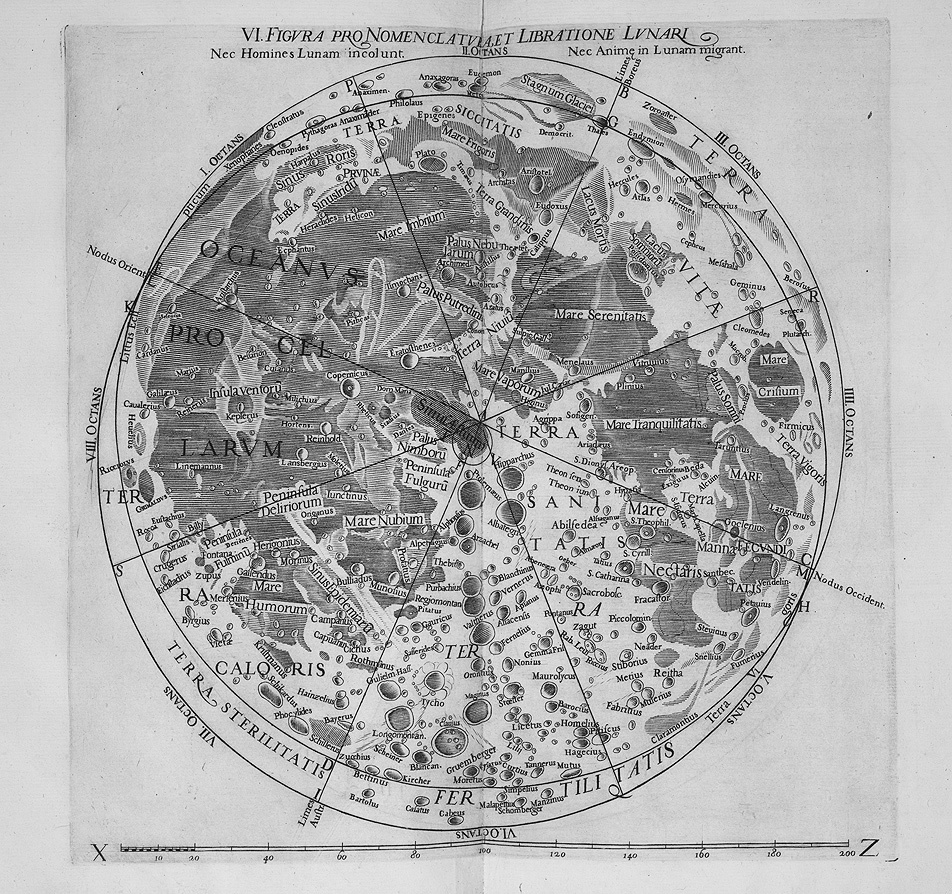
During the three-ish billion years since the lunar basins were formed, several large craters have been overlain upon them. The aforementioned crater Copernicus’ 800 million year old impact scar is visible with unaided eyes and binoculars – but telescope views will reveal many more interesting aspects of lunar geology. Several nights before the moon reaches its full phase, Copernicus exhibits heavily terraced edges (due to slumping), an extensive ejecta blanket outside the crater rim, a complex central peak, and both smooth and rough terrain on the crater’s floor. Around full moon, Copernicus’ ray system, extending 800 km in all directions, becomes prominent. Use high magnification to look around Copernicus for small craters with bright floors and black haloes – impacts through Copernicus’ white ejecta that excavated dark Oceanus Procellarum basalt and even deeper highlands anorthosite.
The many ray systems spreading across the full moon’s face are visible in binoculars. The rays are composed of material that has been thrown radially outwards when objects that slammed into the moon created its more recent craters. The rays are particularly apparent when the moon is lit face-on, as it is around the full phase. Viewed in a telescope, major rays can be shown to be chains of small secondary impact craters excavated by the falling chunks of excavated rock (or ejecta), and by the scattered debris itself. Impacts on the light-coloured lunar highland rocks tended to spread white rays over the surrounding darker mare regions – but sometimes the inverse happens.
Some ray systems are enormous – spanning half the moon’s disk! The ray system of the crater Tycho is a fine example of that. Tycho is the very bright crater located in the south central part of the moon. Its rays are largely missing on the left-hand (lunar western) side, suggesting that its impactor, an asteroid 8 to 10 km in diameter, arrived from the west at an angle less than 45° above the lunar surface, throwing the ejecta in front of it, mainly to the east. In a telescope, you can see that Tycho is encircled by an asymmetrical dark blanket of rubble that is about as wide as the crater’s 85 km diameter. The dark colour is probably basaltic rock excavated from deep below the crust. Tycho and its rays are bright because it is a relatively young crater – only about 109 million years old. The dinosaurs were walking the Earth when the violent event happened! It’s too bad they couldn’t leave us a record of what they saw!
The small crater Proclus is located at the lower left edge of Mare Crisium, the round grey basin near the moon’s upper right edge (northeast on the moon). Proclus’ bright rays only extend toward the right-hand side of the crater, mainly onto Crisium – again due to a very shallow impact trajectory. Many of the dark maria have a single white ray crossing them. See if you can trace them back to their origin.
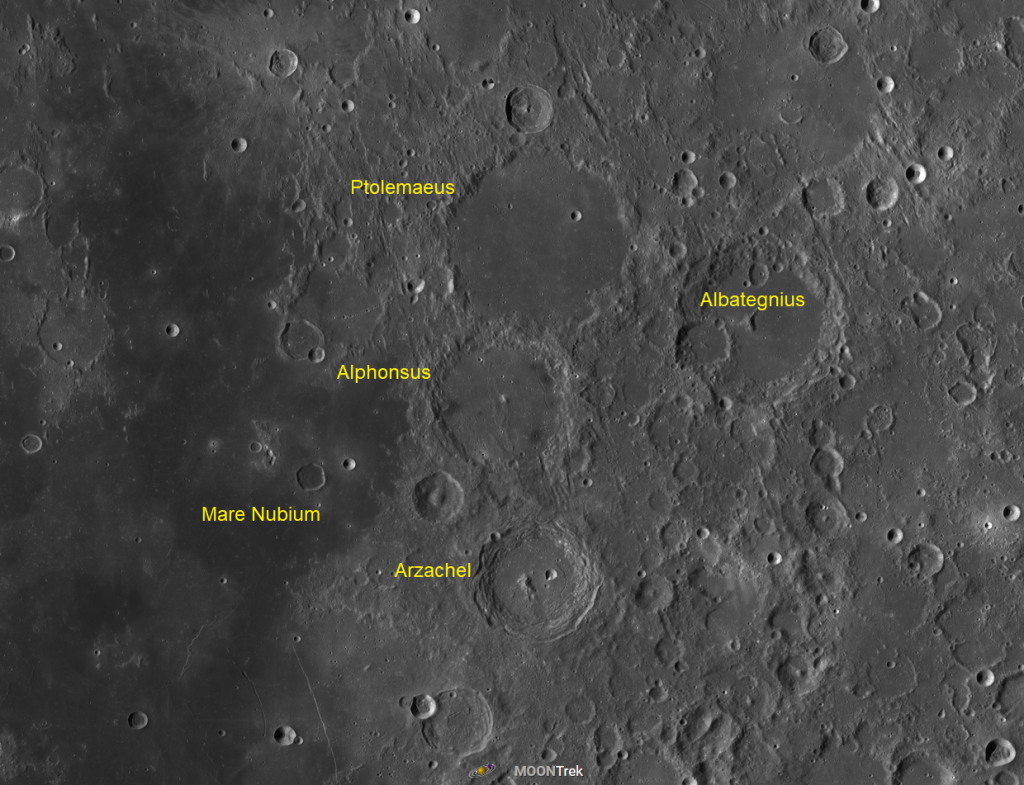
While the moon is quite full, you can use your telescope to look at the dark stains left behind by extinct volcanoes on the moon! Alphonsus is a 110 km wide crater located just south of the moon’s centre, on the upper right shore of Mare Nubium. Any size of telescope will reveal a triangle formed by dark spots on the crater’s floor near its left and right rims. Those are ash deposits. Atlas, another crater with similar markings, sits in the northern region of the moon, about halfway between the northern shore of Mare Serenitatis and the edge of the moon.
The Full Pink Paschal Mini Moon
When the moon rises over the eastern horizon at sunset next Saturday, April 12, it will be shining very close to Virgo’s brightest star Spica, which located is 263 light-years away from our sun. The moon will officially reach its full moon phase at 8:22 pm EDT or 5:22 pm PDT, which converts to 00:22 Greenwich Mean Time on Sunday. Around that time, the full moon will also pass in front of (or occult) Spica for observers located within a zone extending from Panama southeast across northern South America, and ending near the southern tip of Africa. Surrounding regions will see Spica near the moon.
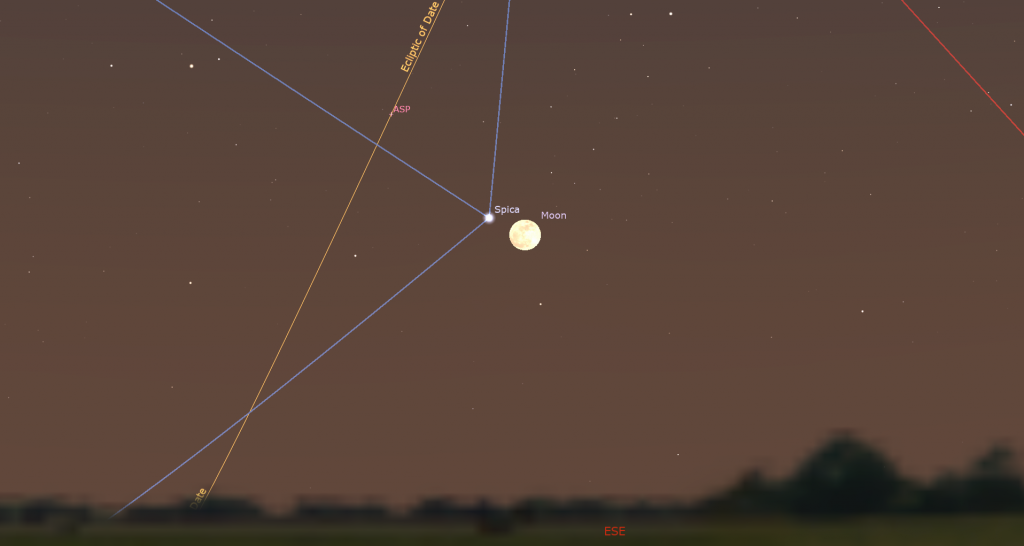
April’s full moon always shines in or near the stars of Virgo (the Maiden) or Libra (the Scales). Full moons are, by definition, opposite to the sun in the sky, so they always rise in the east as the sun sets, and set in the west at sunrise – but lunar phases occur independently of Earth’s rotation. This full moon will occur less than 23 hours before its monthly apogee, making it the smallest full moon in 2025.
Every culture around the world has developed its own set of stories for the moon, and every month’s full moon now has one or more nick-names. The indigenous Ojibwe groups of the Great Lakes region call the April full moon Iskigamizige-giizis “Maple Sap Boiling Moon” or Namebine-giizis, the “Sucker Moon”. For them it signifies a time to learn cleansing and healing ways. The Cree of North America call it Niskipisim, the “the Goose Moon” – the time when the geese return with spring. For the Mi’kmaw people of Eastern Canada, this is Penatmuiku’s, the Birds Laying Eggs Time moon. The Cherokee call it Kawonuhi, the “the Flower Moon”, when the plants bloom.
For Europeans, April’s full moon is commonly called the Pink Moon, Sprouting Grass Moon, Egg Moon, or Fish Moon. All of these terms reflect the changes in the natural environment at this time of year. It seems that “pink” refers to the phlox flowers that bloom first during spring in eastern forests – and NOT to the way the moon will appear!
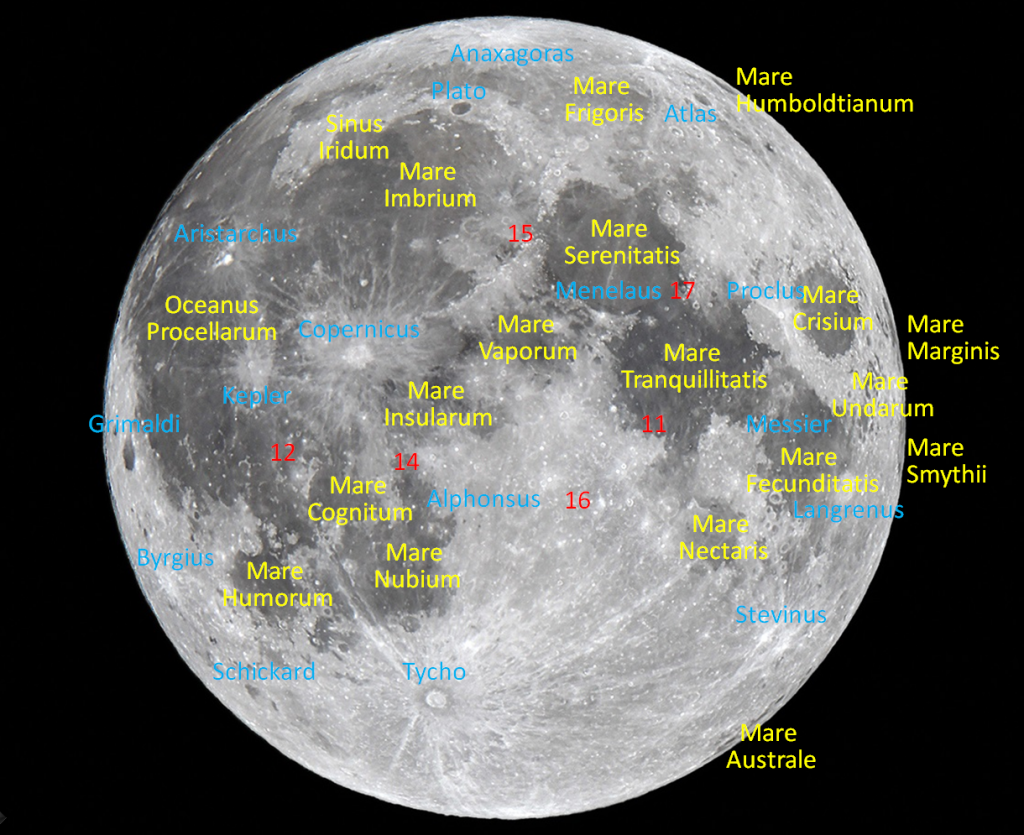
Greetings to those who observe Passover. Easter Sunday and Pesach (Passover) each have an astronomical connection to the full moon, with the Jewish Passover pre-dating the Christian Easter. Some believe that a full moon allowed for safer travelling by religious pilgrims of the time.
In 325 CE the Council of Nicaea determined that the moveable feast of Easter should be observed on the Sunday following the first full moon that occurs after the vernal equinox, officially known as the Paschal Full Moon. The council fixed the equinox at March 21, but the astronomical timing of the equinox actually varies a little bit, and even occurs a full day early on leap years. This year, the equinox occurred on March 20 and the full moon will be April 12-13, so Easter will be observed on Sunday, April 20. The name “paschal” is derived from “Pascha”, a transliteration of the Aramaic word meaning Passover.
The Paschal moon controls the timing of Easter and Passover in different ways – which is why they are sometimes a month apart. Passover or Pesach is celebrated from the 15th through the 22nd of the Hebrew month of Nissan in the Jewish lunar calendar. Nissan began on March 30, when the new moon could first be spotted in Israel, so Passover will commence at sundown on Saturday, April 12 and end at nightfall on Sunday, April 20. Lunar calendars drift from solar calendars because there are 12.3 lunar months in a 365.25 day solar year. To correct for that, an intercalary or leap-month is inserted about every three years. In years when the post-equinox full moon occurs early, as it was in 2024, Jewish religious leaders delay Passover by inserting a second month of Adar, called Adar II, to ensure that spring-like weather conditions (warmer temperatures and flowers in bloom) have arrived in Israel. The earliest that Passover can occur in our Gregorian calendar is March 25, which will next happen in 2089.
The Planets
Ever since the great planetary parade of late winter, we have been bidding adieu to the evening planets as they, and the stars beyond them, are carried daily downward and into the western twilight by the motion of Earth around the sun. This week will be the swan song for Uranus, which for months has been available for viewing in the evening and overnight sky near Jupiter and the bright Pleiades Star Cluster in Taurus (the Bull).
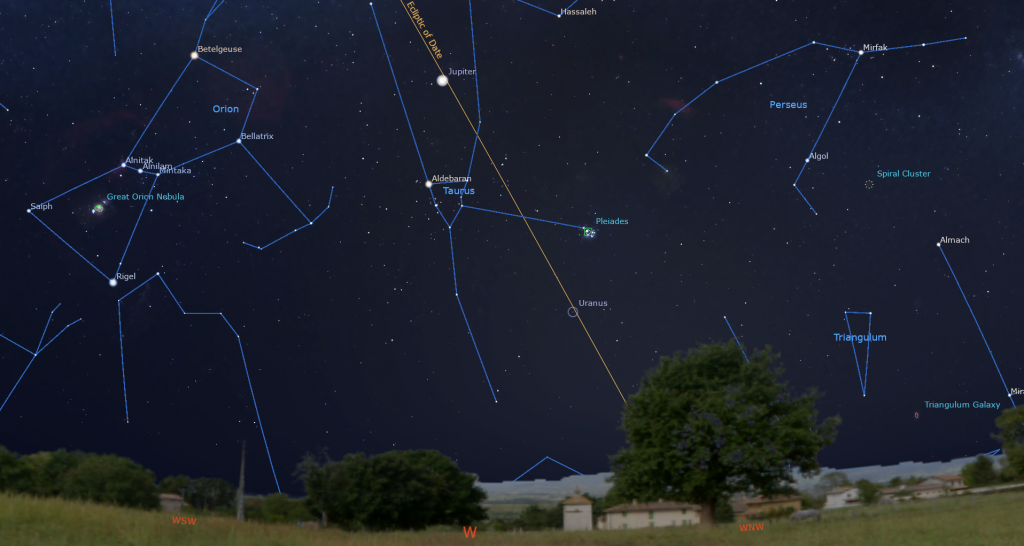
With its magnitude of 5.8, Uranus is possible to see with unaided eyes from a dark site, and it’s quite easy to see with binoculars or a backyard telescope when the moon isn’t interfering too much. But it is just one tiny, blue-green dot among several thousand stars of similar brightness, making it hard to pick out without help. On top of that, fainter objects are harder to observe when their light is being diminished by the thicker atmosphere we see them through while they are low in the sky.
Uranus has already been in that boat for a couple of weeks. After dusk it is located only about two fist diameters (or 20°) above the western horizon, a palm’s width below the Pleiades. By the end of this week, it will have migrated even lower by about that same amount. The increasingly bright moonlight will add to the challenge. Uranus will pass the sun in mid-May and then join the pre-dawn planet party in summer – but it won’t really be observable again until pre-dawn during July.
The next planet to leave the scene will be Jupiter. We have about another four weeks to see it reasonably well through telescopes at mid-northern latitudes in early evening, and then it will become just a bright dot over the western horizon after sunset until it disappears completely in early June. Mars will fly solo at night until it, too, departs in mid-July – just as Saturn begins to rise around midnight.
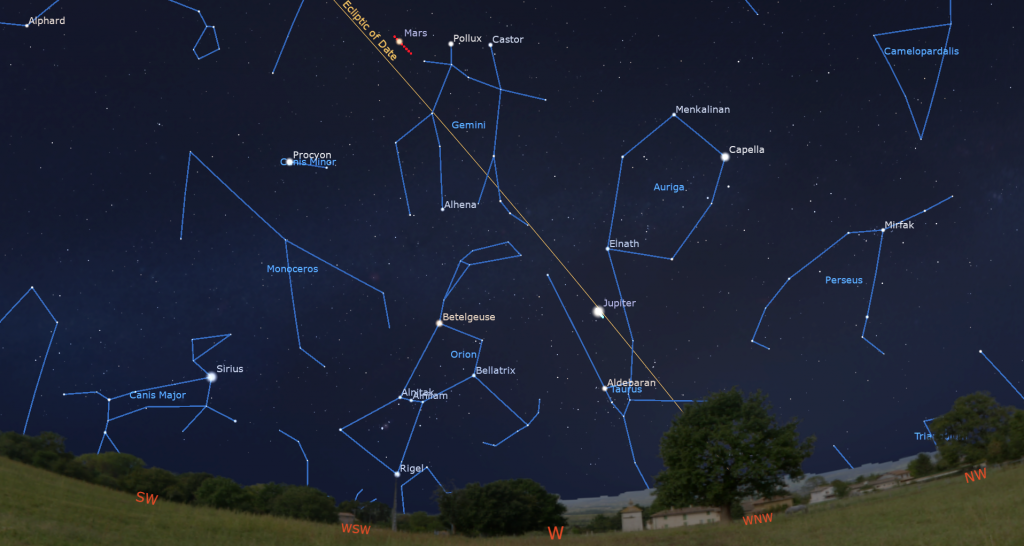
This week, bright Jupiter will become visible halfway from the horizon to the zenith while the western sky darkens after sunset. You’ll get nice views of the big planet through binoculars and telescopes until about 10:30 pm local time. It will set around 12:30 am local time. Taurus’ brightest star, reddish Aldebaran will shine just below Jupiter, while reddish Betelgeuse is off to the planet’s left and yellowish Capella in Auriga (the Charioteer) gleams to its upper right. Over the next month, Jupiter’s easterly prograde motion will carry it farther from Aldebaran.
When viewed in any size of telescope, Jupiter will display a large disk striped with several dark brown belts and beige light zones, all aligned parallel to its equator, which is tilted whenever the planet is descending in the west. With a better grade of telescope, Jupiter’s Great Red Spot, a cyclonic storm that has raged for hundreds of years, will be visible for several hours when it crosses the planet every 2nd or 3rd night. For observers in the Americas, the GRS will cross Jupiter’s disk during early evening tonight (Sunday), Friday, and next Sunday, and also around 11 pm Eastern time on Tuesday. If you have any coloured filters or nebula filters for your telescope, try enhancing the spot with them.
Any size of binoculars will show you Jupiter’s four Galilean moons named Io, Europa, Ganymede, and Callisto lined up beside the planet. Those moons complete orbits of the planet every 1.7, 3.6, 7.2, and 16.7 days, respectively. If you see fewer than four moons, then one or more of them is crossing in front of or behind Jupiter, or hiding in Jupiter’s dark shadow – or two of the moons are very close together, or one moon is eclipsing or occulting another one.
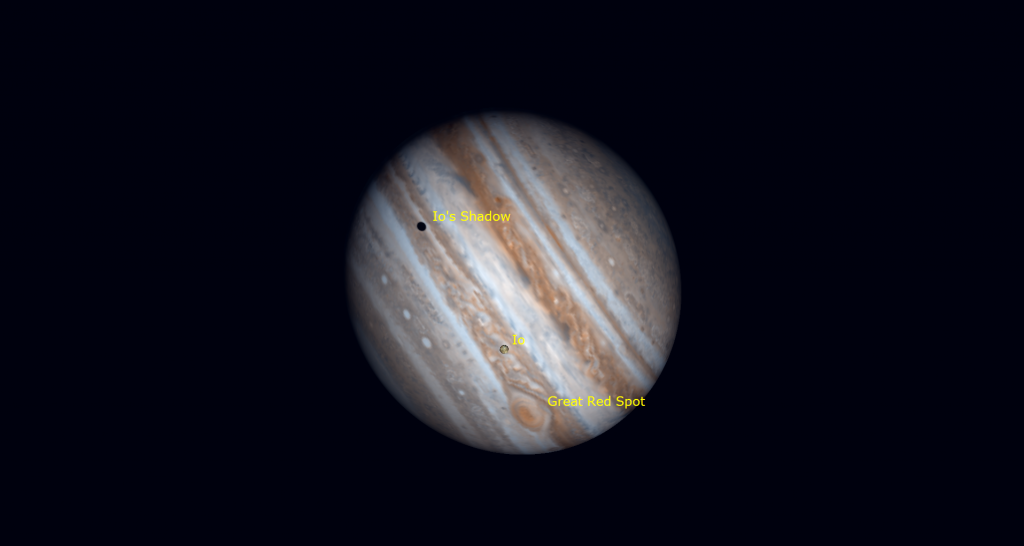
From time to time, observers with good quality telescopes can watch the black shadows of the Galilean moons travel across Jupiter’s disk. In the Americas, Io’s small shadow will follow the great red spot across Jupiter on Friday evening, April 11 between 9:40 pm and 11:45 pm EDT (or 01:40 to 03:45 GMT on Saturday). Europa’s small shadow will cross Jupiter on Saturday evening, April 12 between 9:51 pm and 12:25 am EDT (after Jupiter sets). That’s 01:51 to 04:25 GMT on Sunday). Additional shadow crossings will be visible in other time zones.
After the sky darkens in evening, reddish Mars will need be shining very high in the southwestern sky lined up on the lower left (or celestial southeast) of the two bright stars Pollux and Castor in Gemini (the Twins). Mar will shift a little farther from Pollux over this week while it also diminishes a little in brightness. You can view Mars through a telescope until the wee hours of the night, but it’s very small nowadays.
The rest of the planets are gathered above the eastern horizon before sunrise, but Venus is the only one that you’re likely to be able to spot unless you live in the tropics, where the up-down angle of the solar system’s plane will let Mercury and Saturn shine higher and in a darker sky before sunrise.
This week at mid-northern latitudes, the sun will be rising at about 6:45 am local time. Brilliant Venus will rise about 80 minutes before then, so you can catch sight of it between the trees or buildings until almost sunrise. Venus is swinging farther away from the sun every morning, so it will soon rise while the sky is still dark and reach a higher point in the morning sky before the daylight hides it. At the same time, Venus will be ending its retrograde motion through the western fish of Pisces on Thursday. The movements of Mercury and Venus are complex because they swing east and west past the sun due to their own orbital motion while we are viewing them from our own moving planet! In good binoculars or a telescope, Venus will show a slim, waxing crescent phase and a large disk size – but turn those aids away from the eastern horizon before the sun starts to rise.
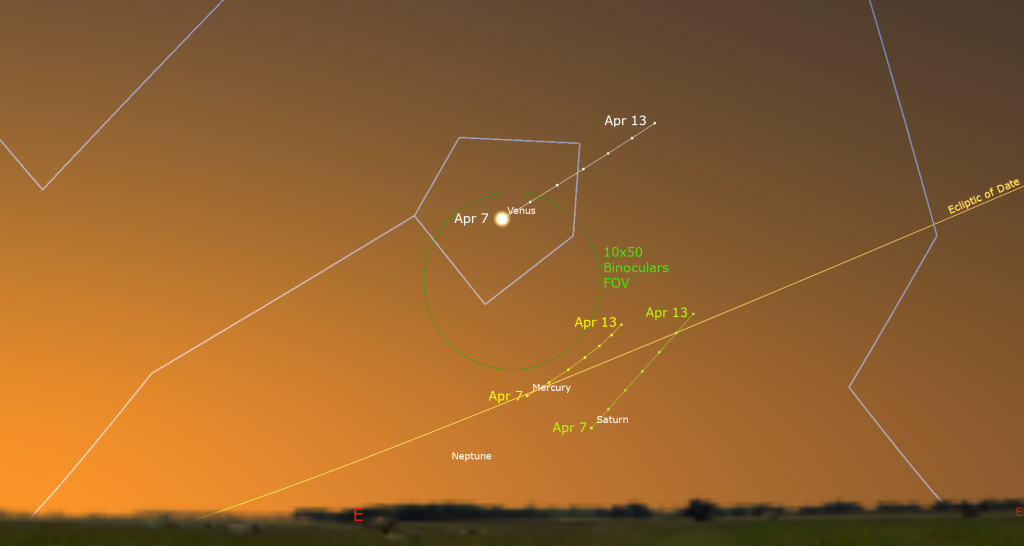
Mercury will clear the eastern horizon around 6 am local time. This week it will be located a generous palm’s width below (or 7° to the celestial southeast of) Venus. The speedy planet will become higher and more visible every morning until late April. Fainter Saturn will be located a thick thumb’s width below Mercury, or nearly a fist’s diameter to Venus’ lower right (or celestial south). That planet’s rings are currently nearly edge-on to Earth, but only tropical observers can hope to see that. Neptune will be out of sight, but present, to the lower left of Mercury. We’ll be able to get decent views of Saturn and Neptune from the end of May onwards.
Public Astronomy-Themed Events
Every Monday evening, York University’s Allan I. Carswell Observatory runs an online star party – broadcasting views from four telescopes/cameras, answering viewer questions, and taking requests! Details are here. They host in-person viewing on the first clear Wednesday night each month. Other Wednesdays they stream views online via the observatory YouTube channel. Details are here.
On Friday, April 11 from 8:30 to 10:30 pm EDT, the in-person Astronomy Speakers Night program at the David Dunlap Observatory in Richmond Hill, Ontario will feature Dr. Charles-Edouard Boukaré of York University. His talk will be What’s Inside a Rocky Planet? After the presentation, participants will view interesting celestial objects through telescopes on the lawn (weather permitting). More information and the registration link is at ActiveRH.
Space Station Flyovers
The ISS (or International Space Station) will not be visible gliding silently over the Greater Toronto Area this week.
Keep your eye on the skies! I love getting questions and requests. Send me some!